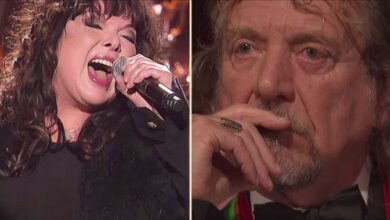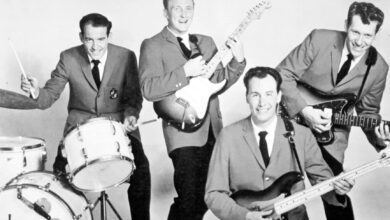The Toys’ ‘A Lover’s Concerto’ Bridges Classical Music and Pop Perfection in 1965
In the vibrant musical landscape of 1965, amidst the British Invasion and Motown’s golden age, one song managed to carve out a distinct place by marrying 18th-century classical composition with the breezy innocence of girl group pop. “A Lover’s Concerto” by The Toys wasn’t just a hit—it was a revelation. Taking a melody inspired by Christian Petzold’s “Minuet in G major,” the song transformed a piece known to piano students worldwide into a soaring, danceable pop anthem. Upon release, it climbed to No. 2 on the Billboard Hot 100 and No. 1 on the Cash Box chart, eventually selling over two million copies. Its success was not only musical but cultural—bridging centuries of musical tradition and capturing the hearts of a generation looking for both sophistication and sweetness.
The Toys were a trio from Jamaica, Queens, made up of Barbara Harris, June Montiero, and Barbara Parritt. Their fresh voices and polished image set them apart in a crowded market of girl groups. What truly distinguished The Toys was their blend of classical finesse and modern flair, a combination fostered in part by their work with producers Sandy Linzer and Denny Randell. Harris, the lead singer, brought a clarity and control to her vocals that rivaled many of her contemporaries, and her upbringing in gospel and choir settings lent a spiritual elegance to her phrasing. While The Supremes and The Ronettes ruled the charts, The Toys stepped forward with an unexpectedly academic twist—pop music with a baroque backbone.
The story behind “A Lover’s Concerto” is almost as memorable as the song itself. Linzer and Randell, two classically trained songwriters, were toying with the idea of blending a classical melody with modern lyrics and rhythm. Petzold’s “Minuet in G,” long misattributed to J.S. Bach, had a melody that was simple, stately, and unmistakably memorable. They added a 4/4 beat, infused it with rich harmonies, and wrapped it in the vernacular of 1960s love songs. The concept was experimental, yet instantly catchy. The result was a track that felt both sophisticated and effortlessly radio-friendly, an unusual feat in a time when classical and pop music occupied vastly different cultural lanes.
The recording process was meticulous. Linzer and Randell arranged a lush orchestration that included harpsichord-style piano, sweeping string flourishes, and a tight rhythm section, giving the song its refined-yet-swinging character. Barbara Harris’s vocal was recorded in just a few takes, her tone exuding warmth and poise. The production leaned on dynamic contrast, balancing the rigid elegance of the minuet with the freedom of pop stylings. The producers layered harmonies reminiscent of doo-wop, blending old and new to create something entirely unique. Unlike many pop songs of the time, “A Lover’s Concerto” was both danceable and introspective—reaching listeners on multiple levels.
Upon release in August 1965, the song was met with immediate acclaim. It peaked at No. 2 on the Billboard Hot 100, just behind The Beatles’ “Yesterday,” and spent 15 weeks on the chart. It topped the Cash Box chart and was also a hit overseas, particularly in the UK and Canada. Critics praised its inventiveness, and it was a frequent pick on jukeboxes across the country. Its crossover appeal was particularly notable: it attracted pop audiences, classical enthusiasts, and even jazz musicians, some of whom covered the song in instrumental formats. The Toys suddenly found themselves on national television shows, including American Bandstand, and were launched into the spotlight seemingly overnight.
More than a chart success, “A Lover’s Concerto” shifted perceptions about what pop music could be. At a time when genres were often siloed, it invited a classical melody into the teen-pop world and made it feel completely natural. The song blurred boundaries and introduced the idea that high art and commercial music didn’t have to be at odds. It also demonstrated that a girl group—typically associated with simple, romantic themes—could deliver something musically complex without losing accessibility. This genre-defying hit helped pave the way for later acts to experiment with orchestral elements in mainstream pop.
For The Toys, the song was transformative. While they would not achieve the same level of success with future releases, “A Lover’s Concerto” catapulted them into a brief but bright stardom. They toured internationally, shared bills with giants like James Brown and Marvin Gaye, and recorded a full-length album that included more classical-pop hybrids. Although internal challenges and shifting musical tastes eventually led to their quiet fade from the spotlight, the song remains a defining moment in their legacy and in 1960s pop at large.
The song’s influence can be seen in the rise of baroque pop and chamber pop—a movement that would later be embraced by artists like The Left Banke, The Zombies, and even The Beatles in their Sgt. Pepper era. Its success gave producers and musicians permission to draw from classical sources, helping to diversify the sonic palette of mainstream music. It also demonstrated that young listeners were open to musical sophistication, as long as it was presented with charm and energy.
Over the years, “A Lover’s Concerto” has been covered by various artists, including Sarah Vaughan, Kelly Chen, and even The Supremes. Each rendition highlights a different facet of the song’s versatility—from jazz interpretations to dreamy, slowed-down ballads. But none quite capture the effervescent magic of The Toys’ original, which remains definitive. Its unique blend of past and present is what gives it lasting power.
Interestingly, the song’s success coincided with a wave of renewed interest in classical music among American audiences, especially younger listeners. At a time when music education was still robust in schools, the familiar melody served as a bridge between generations. For many, it was their first exposure to classical music outside the classroom, repackaged in a format that felt cool and contemporary.
Decades later, “A Lover’s Concerto” continues to resonate. It’s a staple on oldies radio, has been featured in numerous films and TV shows, and remains a favorite in nostalgic playlists. Its timeless charm lies in its ability to be both nostalgic and forward-looking—a rare quality in a pop single. The melody lingers long after the final note, a testament to the song’s elegant construction and heartfelt delivery.
In hindsight, the track marked a quiet revolution. It helped open the doors for classical crossover hits and showed that popular music could be both catchy and cultured. Its sophisticated arrangement and warm harmonies set a standard for what pop could aspire to be. And though The Toys had a brief moment in the spotlight, that moment was luminous.
While The Toys may not have had the extensive discography of some of their peers, their legacy rests firmly on this one luminous gem. “A Lover’s Concerto” remains not just a highlight of 1965, but a shining example of musical ingenuity. In bridging centuries and genres, it created a sound that was both new and timeless—one that continues to enchant listeners nearly 60 years later.



